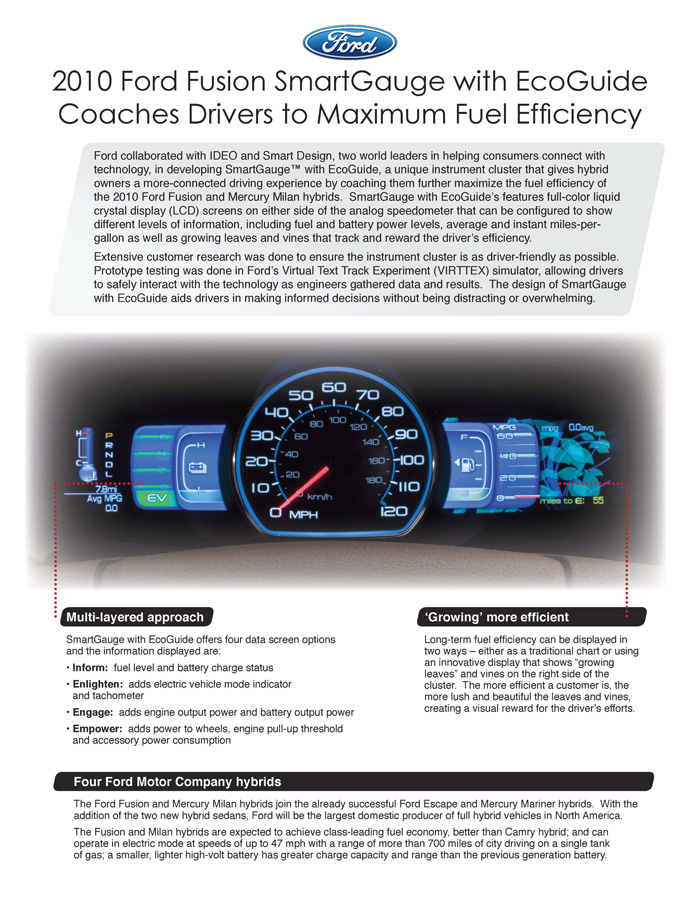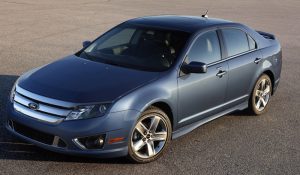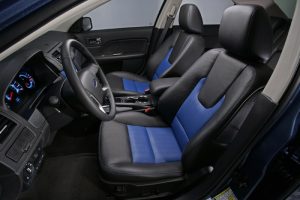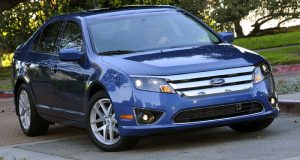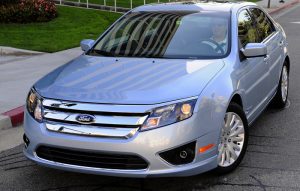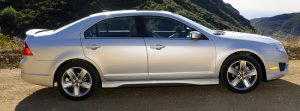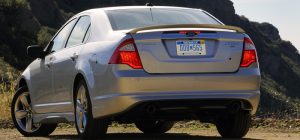For the 2010 model year, the new Ford Fusion lineup expands to include an all-new hybrid model that offers class-leading fuel economy, besting the Toyota Camry hybrid by at least 6 mpg in the city; innovative new SmartGauge™ with EcoGuide coaches hybrid drivers to maximize fuel efficiency
Fusion will offer three fuel-efficient gasoline engine options – the Duratec 2.5-liter I-4 and enhanced 3.0-liter V-6 and 3.5-liter V-6 Duratec engines. Fusions equipped with the 2.5-liter I-4 engine are expected to deliver at least 3 mpg better on the highway than the Honda Accord and 2 mpg better than the Toyota Camry. The 3.5-liter V-6 powers the all-new Fusion Sport model
Class-exclusive features, including Ford SYNC™, SIRIUS® TravelLink™, BLIS™ (Blind Spot Information System) with Cross Traffic Alert and Sony-branded audio set Fusion apart from other mid-size sedans
The 2010 Ford Fusion will be available in dealer showrooms in spring 2009
Ford’s new 2010 Fusion is set to shake up the cut-throat mid-size sedan segment when it goes on sale early next year, bringing an all-new hybrid that will deliver the best fuel economy of any sedan in America, unsurpassed 4-cylinder gasoline fuel economy, more power, class-exclusive technologies including a blind spot detection and warning system and Ford SYNC, more total passenger and luggage capacity than the Toyota Camry, plus proven quality and reliability that has been recognized by the top consumer groups and magazines.
Designed to stand out
Ford’s attention to detail with the freshened Fusion begins with a new design that gives the car a look that is both sportier and more upscale as well as improved aerodynamics. The car’s newly designed front end, including a powerfully domed hood, and new headlamps, grille and larger fog-lamp area further enhance the sporty nature of the 2010 Fusion. Aerodynamic enhancements and new underbody shields further boost Fusion’s fuel economy.
Overall, the wider, sportier look aims to make Fusion even more appealing to customers eager for a fun-to-drive mid-size sedan.
With all models, the interior design team created a more contemporary, technical look with metallic new finishes on the instrument panel that carry through on the center console, doors and steering wheel. The all new instrument panel is finished with a soft upper and lower skin and has much less hard plastic than Japanese competitors.
The instrument panel displays and switches have also been updated with a contemporary iced blue lighting. A redesigned leather wrapped steering wheel with form fitting palm swells, a new shifter, and wrapped and padded armrests increase the Fusion’s sportiness and comfort at all key driver touch points.
The seats received a makeover, as well. The seat contour has been revised, with more side support and overall a more comfortable seat with smoother bolsters and more-textural inserts. The seats also feature contrasting stitching and leather inserts to give the Fusion even more attitude, befitting this mid-size sedan.
The gauge cluster has been designed with day time backlighting, a black lens, and 3-D elements to create a high tech jewel-like appearance, similar to a fine watch. Drivers will be greeted by a new “welcome” sequence that makes the Fusion seem as if it’s coming to life. Gauge needles sweep back and forth as the lighting and new chimes come on. The ambient lighting system offers the option of illuminating the front and rear footwells and front cup holders.
Fuel-efficient and more powerful powertrain lineup
Both the inline four-cylinder and V-6 engines are upgraded for both improved fuel economy and power. The standard Fusion S model equipped with Ford’s new 2.5-liter I-4 engine is expected to deliver at least a 6 mpg improvement versus the 2009 model on the highway, resulting in fuel economy that is at least 3 mpg better than the Honda Accord and 2 mpg better than the Toyota Camry.
The 2.5-liter I-4 engine horsepower and torque also have been improved from the car’s outgoing 2.3-liter 4-cylinger engine, jumping to 175 hp and 172 ft.-lbs. of torque from the previous 160 hp and 156 ft-lbs. As a result, 0-60 performance improves by more than a second, now topping Camry and Accord.
The 2010 Fusion features an all six-speed transmission lineup, including for the new 2.5-liter I-4 engine, which is available with either a six-speed manual or automatic transmission. The previous 2.3-liter I-4 in the Fusion was available with only five-speed transmissions.
The additional gear on the I-4 provides better drivability and performance as well as fuel savings, said Matt Hettenhouse, Powertrain Team Leader for the Fusion. “The gear ratios and the overall span of the transmissions allow us to have a more-efficient and higher performing shift schedule,” he said.
The first gear can be made a little deeper, which provides smoother acceleration. At the top end, a higher gear allows the engine to run slower in highway conditions, which also aids fuel economy.
Ford’s proven Duratec30 3.0-liter V-6 engine was also improved on the 2010 model, delivering highway fuel economy gains of at least 1 mpg city and 2 mpg highway. Horsepower in the 3.0-liter V-6 also increased to 240 hp and 222 ft.,-lbs, up from 221 hp and 205 ft.-lbs. in the previous version.
The 3.0-liter engine is now flex fuel-capable and can run on E-85 ethanol, which delivers even more horsepower – up to 250hp. For maximum performance, the Fusion Sport features a 3.5-liter V6 that has 263 hp and 249 ft-lbs of torque on runs on standard unleaded fuel.
Front-wheel drive and on-demand all-wheel drive are available with models with a 3.0-liter engine and with the new Fusion Sport 3.5-liter engine. Both V6 engines are also available with SelectShift for individual gear control. The versatility in the powertrain systems creates a wide range of options for customers designed to fit every need.
The 2010 Fusion now comes equipped with Electric Power Assist Steering (EPAS) system on 2.5- and 3.0-liter models, improving the driving dynamics of the vehicle while delivering greater fuel savings because the steering system is operated by the electrical system rather than the engine.
Additionally, EPAS provides customers with improved steering feel and reduced low-speed efforts that when coupled with a nearly 1 foot smaller turning circle for 2010 makes parking a cinch.
Fusion’s front stay bar and rear suspension link geometry have been revised to improve steering, handling, and ride. The suspension springs, shocks, and sta-bars have also been retuned to take full advantage of the revised geometry and new steering system.
In addition to improvements in the 2010 Fusion’s steering, handling and improved brake pedal feel, the Fusion team also took a look at how to improve the comfort of the car, including reducing wind noise and road noise.
Acoustic windshield, thicker front door glass, new hood insulators, inner and outer dash absorbers, and carpet, revised sealing baffles, additional sound deadening in the trunk, and new interior headliner absorption material are among the improvements made for overall sound level and quality.
Improved body and door sealing also contribute to Fusion’s best-in-class standing in wind noise. Overall, the reduction in wind noise and road noise puts Fusion near some of the best luxury cars in terms of quietness and speech intelligibility. Wind noise, for example, is 3 sones better than Camry and Accord. Models with the I-4 engine are class leaders in wind noise.
All-new hybrid model
For the 2010 model year, the Ford Fusion adds an all-new hybrid model. The Fusion and Mercury Milan Hybrids join the Ford Escape and Mercury Mariner Hybrids, doubling both the size and volume of Ford’s hybrid lineup.
The Ford Hybrid team has developed a powertrain system that combines the best attributes of the gasoline engine and electric battery-driven motors to deliver the optimal experience for the customer in terms of driving performance and fuel economy. Additionally, the propulsion system for the Ford Fusion and Mercury Milan hybrids transitions between gas and electric power and back more efficiently and seamlessly.
The overall system upgrade allows the Ford Fusion and Mercury Milan hybrids to operate longer at higher speeds in electric mode. The hybrid vehicles can operate up to 47 mph in pure electric mode, approximately twice as fast as some competitors. Plus, the city driving range on a single tank of gas is expected to be more than 700 miles.
The next-generation hybrid system features:
New 2.5-liter 4-cylinder engine (155 horsepower/136 lb.-ft. of torque) running the proven Atkinson cycle mated to an electronically-controlled continuously variable transmission or e-CVT.
Intake Variable Cam Timing (iVCT), which allows the vehicle to more seamlessly transition from gas to electric mode and vice-versa. The spark and cam timing are varied according to the engine load to optimize efficiency and emissions.
Enhanced electronic throttle control reduces airflow on shutdowns, reducing fueling needs on restarts.
Wide-band lambda sensor analyzes the air-fuel ratio and adjusts the lean/rich mixture accordingly to keep the system in balance and to minimize emissions.
A new smaller, lighter nickel-metal hydride battery has been optimized to produce 20 percent more power. Improved chemistry allows the battery to be run at a higher temperature and it is cooled using cabin air.
An added variable voltage converter boosts the voltage to the traction battery to operate the motor and generator more efficiently.
A new high-efficiency converter provides 14 percent increased output to accommodate a wider array of vehicle features.
Smarter climate control system monitors cabin temperature and only runs the gas engine as needed to heat the cabin; it also includes an electric air conditioning compressor to further minimize engine use.
The regenerative brake system captures the energy normally lost through friction in braking and stores it. Nearly 94 percent energy recovery is achieved by first delivering full regenerative braking followed by friction brakes during city driving.
A simulator brake actuation system dictates brake actuation and delivers improved brake pedal feel compared to the previous generation braking system.
The Fusion Hybrid also offers drivers a way to be more connected to the hybrid driving experience thanks to Ford’s SmartGauge with EcoGuide, a unique instrument cluster execution that helps coach them on how to optimize performance of their hybrid.
SmartGauge with EcoGuide features two, high-resolution, full-color liquid crystal display (LCD) screens on either side of the analog speedometer that can be configured to show different levels of information, including fuel and battery power levels, average and instant miles-per-gallon.
EcoGuide uses a multi-layered approach to coach the driver to maximum fuel efficiency.
A tutorial mode built into the display that helps the driver learn about the instrument cluster and the hybrid in a whimsical way that does not overpower. Technical enthusiasts will love the detailed gauges that will help them learn to become more efficient in their driving. Everyday drivers will love another new feature in this same gauge cluster. Called “Efficiency Leaves,” the system “grows” leaves and vines on-screen to reward customers for efficient driving.
Drivers can choose one of four data screens to choose the information level displayed during their drives. They are:
- Inform: Fuel level and battery charge status
- Enlighten: Adds electric vehicle mode indicator and tachometer
- Engage: Adds engine output power and battery output power
- Empower: Adds power to wheels, engine pull-up threshold and accessory power consumption
All levels can show instant fuel economy, fuel economy history, odometer, engine coolant temperature, what gear the car is in and trip data (trip fuel economy, time-elapsed fuel economy and miles to empty). The engine coolant temperature indicator turns green when engine conditions are warm enough to allow engine pull-down.
Several other elements help differentiate the Ford Fusion Hybrid from its gas-powered sibling, including unique hybrid “road and leaf” badging on both sides and the rear of the vehicle; unique 17-inch, eight-spoke wheels; eco-friendly seat fabric made from post-industrial 100 percent recycled materials; and a standard 110-volt power outlet.
New Sport model
The base 2010 Ford Fusion already is a fun-to-drive mid-size car. With an even sportier look, a bigger, more-powerful engine, special 18 inch wheels and upgraded suspension tuning to go along with a distinctive interior, the new 2010 Ford Fusion Sport is a dynamic, welcome addition.
The 263-horsepower V-6 Duratec engine is mated to a six-speed automatic transmission with SelectShift. Front-wheel drive is standard, with all-wheel drive available. The sport-tuned air intake system provides the fun-to-drive, powerful and sporty powertrain sound attributes expected in the 2010 Ford Fusion Sport to complement the driving experience.
Building off the improvements for the Fusion line, the 2010 Ford Fusion Sport also features a unique lower grille for a more functional look, larger beveled bright-tip dual exhausts, side rocker moldings, a decklid spoiler and unique Sport badging. Eighteen-inch painted aluminum wheels are standard.
The interior reflects its sporty nature as well. As with the base models, the Fusion Sport’s instrument panel and center console deliver a more-technical, content-driven look. Fusion Sport includes a Charcoal Black interior with a high tech soft touch dark gray finish available. Sport Blue or Sport Red interior accents are also available, depending on exterior color selected. These give the instrument panel and console a sportier look as well, which carries over to the seat inserts and contrast stitching.
Overall, the Fusion Sport is a driver’s car that is both comfortable and exhilarating at the same time.
Exclusive technologies keep consumers connected
New technology features available on the 2010 Fusion include:
Blind Spot Information System (BLISTM) with Cross Traffic Alert, which can help provide extra confidence to drivers in parking lots by alerting drivers sooner of nearby traffic while backing out. It uses two multiple beam radar modules, which are packaged in the rear quarter panels. The radar detects moving objects within a 65-foot range from either side of the vehicle. The radar identifies when a vehicle enters the defined blind spot zone and illuminates an indicator light on the corresponding side-view mirror providing a warning that a vehicle is approaching. An audible alert is sounded as well.
SYNC: The voice-activated hands-free in-car communication and entertainment system developed by Ford and Microsoft. The system fully integrates most Bluetooth-enabled mobile phones and digital media players, providing customers hands-free cell phone and music selection capabilities – plus new 911 Assist and Vehicle Health Report provided with no monthly fees.
911 Assist: When a phone is properly paired, turned on and connected to SYNC, the system is ready to assist in placing a call directly to a local 911 emergency operator in the event of an air bag-deploying accident. The key advantage of SYNC 911 Assist is speed, as calls are placed directly to local 911 operators.
Vehicle Health Report (VHR): SYNC gathers relevant information from the major vehicle control modules and packages diagnostic data into a usable format in a matter of minutes. That data packet is sent to Ford via an 800-number automatically dialed using the customer’s paired and operable mobile phone.
Voice-Activated Navigation, which integrates several functions including voice recognition destination entry, climate control and SIRIUS satellite radio into one easy-to-use system, displaying them on an 8-inch touch-screen display. The navigation system’s text-to-speech function calls out street names while in route to a destination and reads incoming text messages when the system is linked to SYNC. The integrated DVD player is capable of reading CD-Audio, MP3 CDs, DVD, DVD-Audio and DVD-ROM (for digital map updates). A music jukebox function stores more than 150 hours of music. The screen even can be customized with personal photos.
SIRIUS Travel Link™, an industry-leading technology that, when combined with the voice-activated navigation system will provide users with real-time traffic data with accident and incident information, coast-to-coast weather data including current conditions and five-day forecasts, and fuel price information for over 120,000 gas stations. Travel Link also offers sports scores and schedules and a listing of more than 4,500 movie theaters with movie times, theater addresses, movie synopses and more.
Reverse Camera System, which mounts a small camera on the decklid that is activated when Fusion is shifted into reverse, giving the driver a clear view behind the vehicle. The video image is displayed in the optional navigation screen on Fusions equipped with that option or in the self-dimming rearview mirror vehicles without navigation.
Ambient Lighting System allows drivers to customize the interior lighting to suit their mood through seven base colors – ice blue, purple, blue, orange, red, white and green.
Sony-branded audio system. The Ford Fusion is the first mid-size sedan in North America to offer a Sony-branded audio system with surround sound and Sony DSP processing as a factory option. The Sony-branded audio system features 390 watts and 12 speakers that make substantial use of high-quality speaker materials, including polypropylene cones, three-layer soft dome tweeters and large neodymium magnets for most speakers in the system.
EasyFuel™ Capless Fuel-Filler System also is standard. This industry-exclusive feature eliminates the need to touch dirty gas caps and helps to reduce evaporative emissions that create smog and global warming. When fueling is completed and the fuel pump nozzle is removed, the system automatically seals shut.
Cabin Air Filter is standard for the first time on the Ford Fusion. The filter removes respiratory irritants and toxins caused by traffic and industrial pollution. The filter also provides an additional safeguard for the climate control system.
With a bolder new design, class-leading and unsurpassed fuel economy and performance depending on model, a host of segment-exclusive new features and technologies, greater trunk capacity and storage versatility than Chevrolet Malibu, Toyota Camry and Nissan Altima, improved drivability and comfort and even more choice across the lineup, the 2010 Ford Fusion is poised to win over even more mid-size car customers.
Ford Fusion is built at Ford’s Hermosillo (Mexico) Stamping and Assembly Plant and will be in dealer showrooms in spring 2009.
2010 Fusion Exterior/Interior
The redesigned exterior compliments the more powerful and fuel efficient powertrains by providing a look that is sportier, more upscale, and more technical on all models throughout the Fusion line
The new interior design complements the exterior by providing a driver and passenger environment that is more upscale, contemporary, comfortable, and sporty
Ideas in mind, the design team heavily leveraged computer-aided design technology to streamline the design process and drive as many dramatic, dynamic new elements into the new Fusion as possible.
One of the guiding themes was to make the base Fusion S model as sporty as possible and continue that throughout the portfolio all the way to the Sport version.
To create a wider, sportier look for the front, significant changes were made to the headlamps, grille and fog lamps to emphasize the aggressive front fascia. The iconic three-bar grille in particular is larger with a more modern look. Wraparound projector beam headlamps add to the high tech and leaner appearance. The fog lamps are housed below in a trapezoidal-shaped lower opening to help complete the more-muscular look.
Design refinements carry through to the rear of the 2010 Ford Fusion as well, with modernized taillights and decklid to help give the vehicle a more unified look from front to rear. The decklid mounted LED center stop lamp also contributes to the high tech look and better visibility.
A sportier-looking car hints at all the technology inside Fusion, including the latest version of SYNC, Sony-branded audio with SIRIUS satellite radio and the Voice-Activated Navigation system.
The interior design team created a specific look and feel for each member of the Fusion portfolio. Overall, the goal was to create a more detailed, contemporary environment with a more technical look, mirroring the added content found in each model.
The instrument panel was changed, with new metal finishes on the control knobs, and a stainless look that carries through to the doors, center console and steering wheel for a unified theme throughout the 2010 Fusion. The redesigned seats feature contrasting stitching for a more a more modern appearance. The seat bolsters are smooth, with the inserts getting a textural treatment for contrast.
The Fusion S model features a brushed finish with Charcoal Black and Stone. The SEL model adds more wood trim. The Fusion Sport line features a bold look with an anodized finish on the center stack and either red or blue high tech soft touch spears across the binnacle. The red or blue choice is carried through the seat inserts and contrasting stitching. An all-black with a dark stainless finish also is available on the Sport.
2010 Fusion Powertrain
- 2.5-liter I-4 engine offers unsurpassed fuel economy in mid-size car non-HEV segment
- Wide range of powertrain choices available on the 2010 Fusion line, ranging from a 2.5-liter hybrid electric powertrain to 2.5L I-4 gasoline, 3.0L V6 flex-fuel, and 3.5-liter V-6 gasoline, each mated to six-speed transmissions for the first time
- Addition of six-speed transmissions along with other refinements help increase fuel economy versus current model segment leaders
A wide new range of series and content choices in the 2010 Fusion models – S, SE, SEL and Sport – is complemented by a broad array of fuel-efficient powertrain options.
The Fusion S features Ford’s all-new 2.5-liter Duratec I-4 engine, which produces 175 horsepower; the Fusion SE and SEL are available with the Duratec I-4 or the upgraded 3.0-liter V-6 Duratec engine producing 240 horsepower and capable of running on Flex Fuels such as E85 ethanol; and the Fusion Sport carries a 3.5-liter V-6 pumping out 263 horsepower.
All engines are mated to six-speed transmissions. The new combinations overall help increase fuel economy by at least 17 percent on the base I4 model and approximately 10 percent with larger-displacement engines, further underlining Ford’s commitment to producing fuel-efficient powertrain systems that deliver top performance.
Upgraded engine for Fusion S
First launched on 2009 Ford Escape, which has the best fuel economy in the small SUV segment, Ford’s Duratec 2.5-liter I-4 engine gives the 2010 Fusion S 175 horsepower and 172 pounds-feet of torque, an increase of 15 more horsepower and 16 more pounds-feet of torque than the outgoing 2.3-liter engine.
The 2.5-liter engine uses intake variable cam timing (iVCT) technology to optimize valve timing, creating a broad torque curve that helps deliver increased power along with improved efficiency. The powertrain also incorporates electronic throttle control (ETC), dual-mode crankshaft damping, new intake and exhaust manifolds and a new underbody-only catalyst, which help deliver greater fuel efficiency, more power, and lower noice, vibration, and harshness.
3.0-liter V-6 Duratec engine available for SE and SEL
The improved 3.0-liter V-6 delivers 19 more horsepower and 23 more foot-pounds of torque for a total of 240 horsepower and 228 foot-pounds of torque. It is optional on the SE and SEL models. The fuel economy also improves by at least 1 mpg and 2 mpg on the highway.
The 3.0-liter features a new air induction system and ETC as well as an industry-first Cam Torque Actuated (CTA) iVCT technology that uses available camshaft torsional energy rather than pressurized oil to phase the camshafts. This allows for a smaller-displacement oil pump versus traditional hydraulic VCT systems for improved fuel economy.
This innovative method uses torsional energy to move the camshafts similar to the way a hydraulic ratchet works. The system takes oil from one side of the phaser and channels it to the other side, rather than draining one side and filling the other as with a traditional hydraulic system. This allows the CTA system to work more efficiently at all engine speeds and it requires a smaller oil pump, which equates to lower parasitic energy loss.
CTA reduces oil pump flow requirements by approximately 25 percent, producing a fuel economy benefit up to 0.4 percent. In addition, the CTA-based system responds more quickly than a traditional hydraulic oil actuated VCT system, improving tip-in performance feel and contributing to horsepower gains.
The 3.0-liter V-6 Duratec engine also is flex-fuel capable and can run on E85 ethanol, helping Ford deliver on a pledge made to double annual production of vehicles capable of running on renewable fuels by 2010.
3.5-liter V-6 powers Fusion Sport
The award-winning 3.5-liter V-6 Duratec engine joins the Fusion lineup for 2010, powering the Sport model with 263 horsepower and 249 pounds-feet of torque. The 3.5-liter uses a compact, lightweight dual-overhead cam valvetrain for peak power and smooth operation at high RPMs.
This engine also incorporates intake variable cam timing to optimize valve timing for a smooth idle and an impressive broad torque curve with good power.
A high 10.3:1 compression ratio and aluminum cylinder heads designed for high airflow and optimized combustion help complete the package, supporting the engine’s ability to deliver great performance and fuel economy, along with low emissions. Unlike some competitive performance engines, the 3.5-liter Duratec delivers all of this without requiring premium fuel.
Six-speed transmissions improve performance, drivability
The new pairing of Fusion’s engines with the 6F35-Mid automatic transmission further drives the mid-size sedan’s competitive advantage, especially when compared with the outgoing five-speed gearbox that was offered with Fusion’s I-4 models. A five-speed transmission is still the gearbox of choice for the 2.0-liter varieties offered on segment contenders Toyota Camry and Honda Accord.
When the six-speed transmission is paired with the 2.5-liter engine, for example, the Fusion powerpack delivers a 10 percent improvement in fuel efficiency along with increased power. The 3.0-liter configurations increase efficiency by 4 to 6 percent. The engine and transmission improvements combined with other vehicle systems improvements help deliver at least a 17 percent improvement on the base 2.5-liter model and approximately 10 percent on 3.0-liter equipped models.
The Ford transmission team made several specific modifications to the 6F35-Mid transmission to optimize its performance for Fusion, including using different final drive ratios for the 2.5-liter and 3.0-liter, developing an improved converter lock-up for lower operating temperatures and efficiency, recalibrating the converter clutch to accommodate a fuel-saving aggressive deceleration fuel shut-off system as well as other tweaks to diminish parasitic losses.
A SelectShift function also was added to the 3.0-liter application in response to customer requests, giving drivers the option of a fun-to-shift manual experience.
Other Fuel Savers
The Fusion powertrain packages incorporate other advanced fuel-saving and performance technologies, including:
Electric Power Assisted Steering (EPAS). The 2010 Fusion has a rack-driven EPAS system. Available on the 2.5-liter and 3.0-liter engines, energy consumption of an EPAS system is typically less than 7 percent of a conventional hydraulic rack and pinion power steering system, contributing to less fuel consumption. Ford has committed to fit up to 90 percent of its Ford, Lincoln and Mercury products with EPAS by 2012 and first introduced a column-based EPAS system on the 2008 Ford Escape and Mercury Mariner.
Adaptive Spark Ignition. Included on the V-6 configurations, this system can sense what type of fuel is being injected into the motor and communicates the information to the powertrain control module (PCM), which adjusts the spark accordingly. The ignition system features two knock sensors rather than one to further improve performance. These two sensors detect the presence of uncontrolled burning in the chambers more accurately, so the control module can retard engine timing as needed to eliminate the potential for engine knock and pinging. As a result, V6 engines run equally smoothly and are able to deliver power ratings on regular unleaded fuel instead of the more expensive premium.
Aggressive Deceleration Fuel Shut-off. The 3.0-liter V-6 also regulates its gas consumption by using aggressive deceleration fuel shut-off for an efficiency improvement of approximately 1 percent. When the driver releases the accelerator pedal to slow down, the system temporarily turns off the fuel. The flow of fuel seamlessly resumes when the vehicle reaches a low speed or when the driver accelerates again. The system uses the transmission to keep the engine running at a low, more efficient operating point whenever possible. This system will be added to the 2.5-liter lineup later in the 2010 model year.
In addition to improved powertrain performance, better aerodynamics and weight reductions helped deliver fuel economy gains for the 2010 Fusion.
Designers and engineers worked to optimize the airflow over, under and around the 2010 Fusion. Improvements included all-new front and rear fascias, new front and rear tire spoilers, a new underbody engine shield and overall optimization of the cooling air flow into the engine compartment.
Plus, the team eliminated 125 pounds versus the 2009 Fusion. The size of the radiator, for example, was able to be reduced in size by one-third (saving approximately pounds) with no degradation in performance. Also, 16-inch aluminum wheels helped reduce weight and aid aerodynamics while still delivering top performance.
2010 Fusion Featured Technology
New generation of SYNC, which adds 911 Assist and Vehicle Health Report, tops list of technology upgrades in 2010 Ford Fusion
Segment-exclusive Blind Spot Information System (BLIS) with Cross Traffic Alert (CTA) adds peace of mind to customers of fun-to-drive mid-size car
2010 Ford Fusion continues as only car in mid-size class with available all-wheel drive
Not only is the 2010 Ford Fusion fun to drive, it’s fun to enjoy, thanks to segment-exclusive features and new technologies.
Segment-exclusive technology and features on the 2010 Fusion include:
- The next generation of Ford SYNC™, which adds 911 Assist and Vehicle Health Report
- Blind Spot Information System (BLIS) with Cross Traffic Alert (CTA) and Rear Park Assist
- Sony-branded audio system, which features 12 high-quality speakers and two amplifiers
- The next generation of the SIRIUS® Travel Link™ navigation system, which has the largest touch-screen in the mid-size segment
- Ambient lighting
- Easy Fuel™ capless fuel filler
- Available all-wheel drive (AWD)
- Passenger fold-flat seat
Leading the technology enhancements is SYNC, which adds two new features: 911 Assist and Vehicle Health Report (VHR). 911 Assist is designed to assist occupants to place a call to a local 911 emergency operator if an accident that activates an air bag or the emergency fuel cutoff occurs.
Before initiating the emergency 911 call, SYNC will provide a 10-second window to allow the driver or passenger to decide whether to cancel the call. If not manually cancelled within the 10-second window, SYNC will place the emergency call. A brief pre-recorded message will play when the call is answered, and occupants in the vehicle will then be able to talk directly with the 911 operator. Once the call is connected, 911 operators can respond properly.
Vehicle monitoring and appropriate maintenance can save time, money and improve the ownership experience. SYNC’s new VHR feature will make staying up to speed with vehicle maintenance easier than ever at no additional cost. After users register at www.syncmyride.com and activate VHR, they can conveniently generate reports using simple voice commands in the vehicle for display on syncmyride.com.
SYNC VHR collects vehicle mileage and diagnostic data from the major vehicle electronic systems and transfers the data to Ford using the customer’s Bluetooth-paired and connected mobile phone.
A comprehensive report is generated and includes system information and recommended actions for any displayed vehicle warning indicators, open recalls, Ford scheduled maintenance and unserviced maintenance and wear items from previous dealer visits.
Also adding peace of mind to the Fusion driving experience is the Blind Spot Information System (BLIS) with Cross Traffic Alert (CTA) and Rear Park Assist, which are segment-exclusives.
BLIS with CTA uses two multiple-beam radar in the rear quarter panels (one per side) for two different – but important – purposes. BLIS checks the defined blind spot zone, which is about 10 feet from the back of the bumper to the outside mirrors. When a vehicle is detected, an amber light in the outside mirror of whichever side the vehicle is on lights up.
CTA notifies the driver of impending traffic when backing out of a parking spot and warns the driver when a vehicle is detected within three car widths of either side of the car. As with BLIS, the driver is warned with a light in the outside mirror on the side of the traffic. A warning beep also is sounded.
The Ford Fusion is the first mid-size sedan in North America to offer a Sony-branded audio system with surround sound and Sony DSP (Digital Signal Processor) as a factory option.
The Sony system uses Dolby Laboratory’s latest surround processing technology, Dolby Automotive Entertainment Program (DAEP). DAEP brings the home-theater performance of Dolby Pro Logic II technology into the mobile environment.
The system has 12 speakers with two amplifiers and makes substantial use of high-quality speaker materials, including polypropylene cones and three-layer soft dome tweeters.
The voice-activated TravelLink navigation system is upgraded as well. The 8-inch screen, the largest touch-screen in the class, has improved resolution, six-channel DVD-audio capability and voice recognition destination entry.
The system pronounces street names when route guidance is active. Real-time traffic information is available, as are gas station prices. In addition, once the vehicle reaches a low fuel level status, the instrument cluster alerts the driver and automatically populates the navigation screen map with gas stations.
New for 2010 is a smart weather feature embodied in the “nearby weather” button. When this button is activated, the system will automatically find and report weather conditions from the nearest weather station while driving.
Nearly 150 different categories of points of interest are available, making it easier for the customer to find a desired location. Additionally, listings for the top 40 movies playing are available.
The Ambient Lighting System allows drivers to customize the interior lighting of the vehicle to suit their mood through seven base colors – ice blue, purple, blue, orange, red, white and green.
Another clever feature standard on the 2010 Fusion is EasyFuel™ Capless Fuel-Filler System. This industry-exclusive feature helps to reduce evaporative emissions that create smog and global warming. When fueling is completed, and the fuel pump nozzle is removed, the system automatically seals shut. There is no longer a need to handle a dirty gas cap.
Available all-wheel drive and passenger fold-flat seat continue as segment-exclusives. The fold-flat seat, combined best-in-class trunk capacity, adds storage versatility for the 2010 Fusion.
